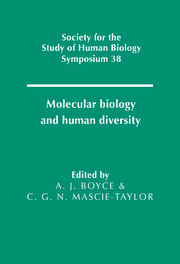Book contents
- Frontmatter
- Contents
- List of contributors
- Preface
- 1 Mitochondrial DNA in ancient and modern humans
- 2 Digital DNA typing of human paternal lineages
- 3 Minisatellites as tools for population genetic analysis
- 4 DNA fingerprinting: development of a technology and its application to the study of human populations
- 5 Kinship, inbreeding, and matching probabilities
- 6 Using the coalescent to interpret gene trees
- 7 Some attempts at measuring natural selection by malaria
- 8 AIDA: Geographical patterns of DNA diversity investigated by autocorrelation statistics
- 9 Mitochondrial DNA sequences in Europe: an insight into population history
- 10 Palaeolithic and neolithic contributions to the European mitochondrial gene pool
- 11 The molecular diversity of the Niokholo Mandenkalu from Eastern Senegal: an insight into West Africa genetic history
- 12 The peopling of Madagascar
- 13 Molecular perspectives on the colonisation of the Pacific
- 14 Population ancestry on Tristan da Cunha–the evidence of the individual
- 15 Linguistic divergence and genetic evolution: a molecular perspective from the New World
- 16 Allelic sequence diversity at the human β-globin locus
- 17 A nuclear perspective on human evolution
- 18 Contrasting gene trees and population trees of the evolution of modern humans
- 19 Methods and models for understanding human diversity
- Index
17 - A nuclear perspective on human evolution
Published online by Cambridge University Press: 19 September 2009
- Frontmatter
- Contents
- List of contributors
- Preface
- 1 Mitochondrial DNA in ancient and modern humans
- 2 Digital DNA typing of human paternal lineages
- 3 Minisatellites as tools for population genetic analysis
- 4 DNA fingerprinting: development of a technology and its application to the study of human populations
- 5 Kinship, inbreeding, and matching probabilities
- 6 Using the coalescent to interpret gene trees
- 7 Some attempts at measuring natural selection by malaria
- 8 AIDA: Geographical patterns of DNA diversity investigated by autocorrelation statistics
- 9 Mitochondrial DNA sequences in Europe: an insight into population history
- 10 Palaeolithic and neolithic contributions to the European mitochondrial gene pool
- 11 The molecular diversity of the Niokholo Mandenkalu from Eastern Senegal: an insight into West Africa genetic history
- 12 The peopling of Madagascar
- 13 Molecular perspectives on the colonisation of the Pacific
- 14 Population ancestry on Tristan da Cunha–the evidence of the individual
- 15 Linguistic divergence and genetic evolution: a molecular perspective from the New World
- 16 Allelic sequence diversity at the human β-globin locus
- 17 A nuclear perspective on human evolution
- 18 Contrasting gene trees and population trees of the evolution of modern humans
- 19 Methods and models for understanding human diversity
- Index
Summary
Introduction
Human genome diversity and recent human evolution are intimately related. The distribution of DNA sequence variation within and among human populations, however one chooses to define those populations, is the result of numerous evolutionary factors (migration, selection, mutation, and random genetic drift) operating throughout the history of our species and its recent ancestors. The emphasis of human diversity studies is shifting from simple description of which populations are ‘more closely related’ to identification of the evolutionary forces and historical events that are responsible for the extant diversity. The patterns of variation seen in mitochondrial, sex chromosome, and autosomal DNA are both the result of and reflect those factors, but differently.
Neither mitochondrial nor Y chromosome DNA is sufficient
Mitochondrial DNA (mtDNA) is relatively easy to study and has been exceedingly valuable in addressing a large number of evolutionary and taxonomic issues in a variety of species. However, it has many limitations and cannot provide information on many very relevant questions–especially those related to the amount of genomic diversity within and among human populations. Also, it can provide only partial information relevant to explaining the causes of the genetic diversity found among human populations. Two related characteristics of mtDNA are the primary reasons for the limitations: the absence of recombination and the maternal pattern of inheritance.
- Type
- Chapter
- Information
- Molecular Biology and Human Diversity , pp. 242 - 264Publisher: Cambridge University PressPrint publication year: 1996
- 10
- Cited by

